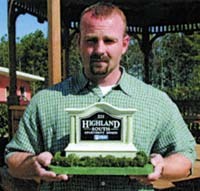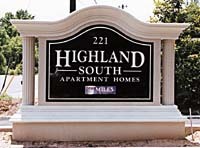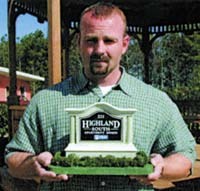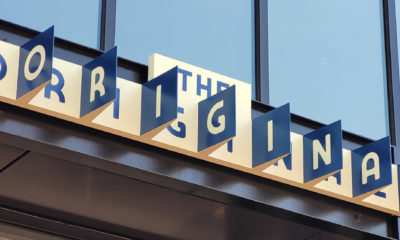Contrary to popular belief, bigger is not always better. Mini-Me, for example, not only upstaged the much larger Dr. Evil, but movie headliner Austin Powers. A collector recently paid Christie’s auction house millions of dollars for a small, 2 1/8-in.-tall portrait of George Washington. And, in an age in which giant Oldsmobiles are being discontinued, little VW Beetles enjoy renewed popularity.
The same holds true for the sign industry: Tiny is tops. In bid proposals, for instance, miniature, to-scale models can serve as valuable sales tools. Fifteen-year-old Woodgraphics (Douglasville, GA) uses models to particularly good effect. The company keeps on-hand models of the 10 standard monument signs it offers. Measuring between 5 and 9 in. high and roughly 1 1/4 in. thick, each double-faced monument is made from two sheets of routed high-density urethane (HDU), glued back to back, and handpainted.
"The faces are magnetic and interchangeable, allowing them to be customized for different clients. Using our GERBER EDGE®, we can print a miniature faux-granite face with goldleaf letters in no time," salesman Jack Caldwell explains. "Then, we paste the face onto one of our miniature plaques, and the plaque is magnetically held onto the mini-monument."
When shown to a customer, the mini-monument is set into Woodgraphics’ standard, green base, and mini "shrubbery" is arranged around the sign. Woodgraphics owner Alan Denyse credits designer Ken Cain and |1137|’s Sabre® router master Jon Keller for the models. Gerber Scientific Products
"We’re always trying to come up with unique tools that put us at a competitive advantage in the market we serve, which is, in general, fancy entry-monument signage," Denyse says.
In addition to the 10 standard monument models, Woodgraphics occasionally makes a custom model. Last year, the company created a custom model when trying to land Miles Properties’ Highland South job. Woodgraphics first took a physical inventory of the signs on Miles’ other properties. During this inventory, the sign company learned Miles often uses monument signs with Roman and/or Greek themes.
Advertisement
With this knowledge, Cain designed a synthetic stucco monument sign with classically styled pylons on either side of the sign face. After Cain completed his design sketch, he and Keller created the sign in miniature. Interestingly, to create the mini-columns on either side of the monument, they purchased small tubes at the hardware store. Using their printer, they output a fluted molded pattern on vinyl, which they adhered to the tubes.
The model served its purpose well, as the sign company landed the $13,000 job. What’s more impressive, however, is that Woodgraphics has parlayed that sign into an expanded contract. The sign company has created four custom monument styles for Miles, which will be used at all 45 properties.
"With each apartment complex, Miles will choose one of the four styles that matches the property. Because the color and design decisions are already made, it streamlines the design process," Denyse explains, comparing to a McDonalds’ Value Meal concept. "It gives them a cost break. Hours of meeting time and design time are eliminated. So Miles isn’t being billed for 16 hours of labor it could otherwise be charged for."
Despite the size of the account, Miles is not Woodgraphics’ largest client.
"They’re one of the smaller people we deal with," Denyse says. "Our biggest market right now is clients with several hundred properties. These clients are interested in branding to present the same image across the nation. This helps investors recognize their different properties, while also creating awareness among transients looking for apartments."
As effective as Woodgraphics’ models are, they’re by no means the company’s only marketing medium.
Advertisement
"We have quite a few things — models, hand renderings and very large-scale, print-outs," Denyse explains.
Particularly innovative, the company’s newest marketing tool is a multimedia "business card" on a mini-CD-ROM. After a less than four-minute-long sales pitch, which includes sign-permitting data, the CD offers custom information, such as the sales rep’s biography, client drawings and contracts.
To assure a professional presentation, Woodgraphics designed the CD’s visuals, hired voice-over speakers and purchased Acid music-making software. With the software, Woodgraphics created custom music and avoided copyright fees.
Denyse credits his marketing manager, Mark Gammill, for the CD: "Mark designed our current Website (www.woodgraphics.com), after teaching himself that software. He redesigned our brochure and printed literature. And then he got multimedia software and created the CD. It’s great, and I’m kind of hard to please."
Denyse concludes, "The goal of marketing is to do something special that customers will remember you by — to show that other sign companies are not making that kind of effort to win the account. Large drawings on an easel only run $150 or so. Mini-monuments don’t cost a lot either — especially if you have standard models already made. All you have to do is print the new face on the printer." Most importantly, he says, customers are truly impressed by the extra effort. "The last client I took a model to said to me, ‘This is the kind of stuff people eat up.’"


 Tip Sheet4 days ago
Tip Sheet4 days ago
 Business Management2 weeks ago
Business Management2 weeks ago
 Women in Signs2 weeks ago
Women in Signs2 weeks ago
 Real Deal5 days ago
Real Deal5 days ago
 Benchmarks16 hours ago
Benchmarks16 hours ago
 Editor's Note1 week ago
Editor's Note1 week ago
 Line Time2 weeks ago
Line Time2 weeks ago
 Product Buying + Technology1 week ago
Product Buying + Technology1 week ago


















